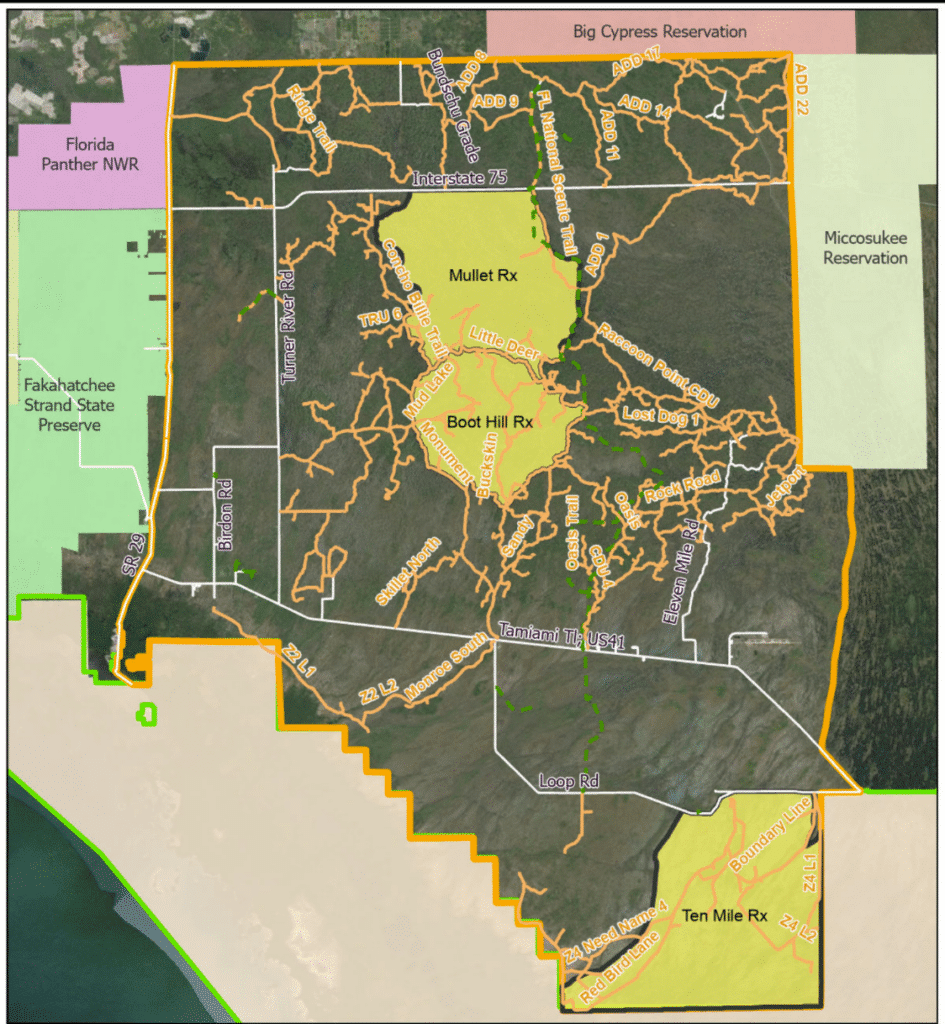Social and environment conditions permitting, prescribed fire operations will continue tomorrow, 01/14/2025 in the Boot Hill Rx in Big Cypress National Preserve. Operations are expected later this week in Everglades National Park. Additionally, prescribed fire ignition operations may continue throughout the month of January in Big Cypress National Preserve & Everglades National Park. The target burn windows below are only estimates and may change depending on environmental conditions, national preparedness level, Superintendent’s approval, and resource availability and State burn authorization and restrictions.
Any of the following units may be burned between January 1, 2025 and January 31, 2025 depending on conditions and local approval.
Please see attached map for exact locations.
BIG CYPRESS NATIONAL PRESERVE
Priority 1: Boot Hill Rx (planned 01/14/25)
Priority 2: Boundary Rx (Ten Mile)
Priority 3: Mullet Rx
EVERGLADES NATIONAL PARK
Priority 1: HID Buffer Rx
Priority 2: Boundary Rx (ROG NW / ROG W / ROG SS)
Priority 3: Block F Rx (expected 01/15/25)
Priority 4: Block J Rx
Priority 5: Block E Rx
Priority 6: Northern Pines / ROG E Rx
Priority 7: Middle Cape Rx
Priority 8: Lostmans Tower Rx
BISCAYNE NATIONAL PARK
No Rx Operations Planned
Fires are a natural and important ecosystem function for Florida’s environment. Using prescribed fire as a land management tool can reduce risk of wildfires to communities and developed areas as well as benefit the ecosystem by renewing wildlife habitats and promoting ecological diversity.
Prescribed Fire Benefits
· Helps reduce the risk of wildfire and protects communities adjacent to natural areas by reducing highly
flammable vegetation.
· Promotes and maintains healthy and resilient fire-adapted ecosystems.
· Improves nutritional quality and nutrient cycling of soil.
· Maintains habitat conditions for plants and animals.
· Maintains biodiversity within fire-adapted habitats by promoting flowering and fruiting of plant species.
· Restores fire to landscapes that no longer experience the natural historic flow of fire due to habitat
fragmentation.
· Helps to manage invasive plant populations.
· Safer, efficient, and more cost effective than wildfire management.
Additional notifications will be sent out prior to project implementation. If you have scheduled activities in the treatment areas or have questions regarding one of the upcoming treatments, please inform the Fire and Aviation Management staff at one of the numbers listed below.
Assistant Fire Management Officer for South FL & Carribean Fire Zone, Michael Gue at 305-338-6069
Everglades Duty Officer at 305-242-7850
Big Cypress Duty Officer at 561-923-5228
Everglades Deputy Chief of Fire and Aviation, Jack Weer at 305-484-8058
Big Cypress Deputy Chief of Fire and Aviation, Orlando Genao 239-695-9280 x1316
South Florida National Parks and Preserve Chief of Fire and Aviation James Sullivan at 305-546-9358scribed

